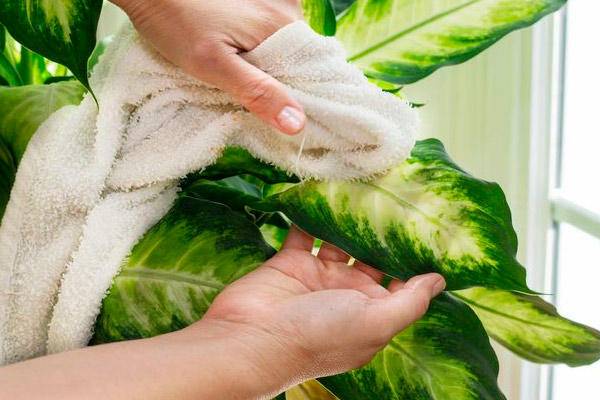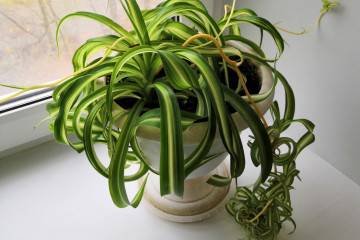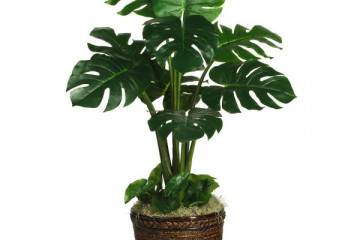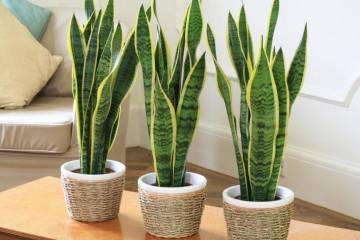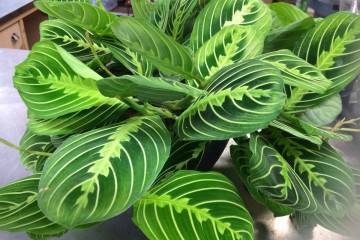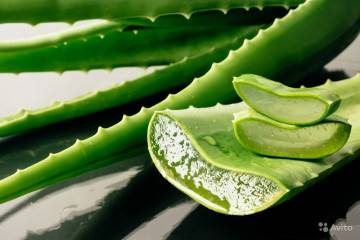Dieffenbachia flower - home care
Content:
Dieffenbachia is a flower famous for its beautiful leaves and speculation about the dangers of keeping it in housing. Many lovers of large-leaved domestic plants do not know how dieffenbachia blooms, and are disappointed when they first encounter a nondescript ear.
What does dieffenbachia look like, which family does it belong to
The flower is a member of the Aroid family, he himself comes from the South American continent. Refers to perennials, evergreen shrubs.
Common varieties
Types of dieffenbachia dieffenbachia differ in size, color of foliage. Common varieties include:
- Dieffenbachia Spotted - defined by the unusual shape of the leaf plate, resembling an egg.
- Dieffenbachia Camilla - has a creamy white foliage with a greenish edging around the edges.
- Dieffenbachia Treelike or bush - has a spreading crown with many branches.
- Dieffenbachia Compact - miniature size, up to 40 cm in height.
Briefly about the history of appearance
The flower is named after the Austrian gardener J. F. Diefenbach. Plants have been used as interior decorations for over 150 years.
Dieffenbachia: home care
When caring for home, dieffenbachia requires compliance with temperature and light conditions, watering, feeding and protection from pests.
Temperature
Comfortable conditions for a flower in summer are 22-25 degrees, in winter - 16-18 degrees. He is afraid of drafts, in the summer he needs to be put on the balcony - because of his love for clean air. Keeping a flower in direct sunlight is dangerous - it will burn the foliage, and ugly defects will appear on the plates.
Lighting
The dieffenbachia plant needs bright lighting - only with it it grows quickly and gives beautiful spotty leaf plates. Direct sunlight can cause burns and further illness.
Watering
The shrub requires regular moistening; weekly, dust should be wiped off the foliage using a damp cloth.
Spraying
In the spring and summer, the plant is periodically sprayed and given a shower. In order not to provoke excessive moisture, the lower part is covered with plastic wrap before the procedures.
Humidity
Indoor plant grows well at high humidity levels. In connection with this feature, it is necessary to constantly look after it: spray it regularly, and place an aquarium next to the box.
Priming
Flower shops offer a special blend designed for dieffenbachia.If desired, you can make a nutritious soil mixture with your own hands: take 1 part of sand, humus and 3 parts of earth each.
Top dressing
Dieffenbachia care involves the introduction of nutrients. Regardless of the variety, the shrub is characterized by rapid growth, which spends a lot of energy. Restorative feeding in the summer months is carried out every 7-10 days. The plant prefers a nitrogenous-organic mixture and special additives designed for variegated species.
Features of winter care
During the dormant period, the plant also needs special care:
- from mid-September to early spring, the flower is not fed;
- with increased dryness of the air, the number of spraying is increased;
- watering is carried out less frequently, as the soil dries.
When and how it blooms
The flowering of dieffenbachia is rarely observed, and only if the regime suitable for it is observed.
Flower shapes
Dieffenbachia flowers are yellowish, small. The inflorescence is represented by an oblong ear, covered with a grayish-green veil. After a while, it darkens.
Flowering period
Dieffenbachia blooms in April or May, the development of the inflorescence lasts 2 weeks. The life span of a flower does not exceed 72 hours.
Pruning
Pruning is carried out under the following factors:
- when the plant is quickly pulled in length;
- damage to the sheets.
The procedure is performed only with gloves - the juice of the bush is poisonous. During this time, there should be no small children and animals in the room. The plant is washed and cleaned with an alcohol solution before and after pruning. The cut is made horizontal, with smooth edges.
How dieffenbachia reproduces
The use of several methods of transplantation is allowed: by seeds, cuttings, propagation by air layers.
Germinating seeds
After purchasing varietal seeds, they are sown in wet sand, and a polyethylene material is stretched over the container. The soil is not watered, it is enough to moisten by spraying water.
For seed growth, it is necessary to observe a temperature regime of 20-25 degrees. After a while, the first shoots will appear, and after the development of 2-3 leaves, the young are transplanted each into their own container.
Rooting cuttings
Cuttings are cut off: after treatment with root growth activators, they are rooted in sand or placed in a humid environment (glass of water or moistened moss). Add 1 tab to the liquid. activated carbon. After the roots appear, the cuttings are transplanted into separate boxes and covered with glass.
Air layering
The stem of dieffenbachia is cut, covered with moss, and polyethylene is wrapped over it. After the appearance of the roots, the film is removed, the cuttings, together with the moss, are transplanted into a separate pot.
Transfer
How to properly transplant dieffenbachia:
- the procedure is carried out after filling the entire box with the root system;
- a seating capacity change is needed every 3 or 4 years;
- every 24 months, the top layers of the soil are removed in the container and fresh substrate is added.
The plant is transferred to a new place along with the root ball, the drainage is poured fresh. The best time for the procedure is late autumn or winter, when the flower is at rest and can bear stress more easily. After manipulation, feeding is not needed, especially if a store-bought soil mixture was used.
Possible growing problems and diseases
Violation of the requirements for the care of an ornamental tree often leads to the development of diseases. Sometimes the problem is related to pest attacks. It is immediately clear what a sick dieffenbachia looks like: all manifestations are reflected in the foliage.
Drops buds and leaves
If the bush is actively getting rid of foliage, then the phenomenon is associated with rot. It is triggered by excessive moisture. You can check the assumption by the state of the soil mixture: even with rare or absent moisture, it does not completely dry out. Treatment consists in the step-by-step cutting of the affected root system and sprinkling of the cut sites with activated carbon.
Leaves turn pale
The blanching of usually bright and colorful foliage is due to direct sunlight. The flower must be rearranged in partial shade, all affected leaf plates must be cut off - they cannot be restored.
The tips of the leaves dry
Drying of the tips of the plates is the first alarm bell, which may be followed by a massive drying out of the foliage. If a feature appeared in an adult plant, then the processes of natural aging are attributed to the reasons. In cases where the entire flower has begun to dry, the source of the problem may be:
- insufficient spraying and moisture;
- increased dryness of the air;
- hot weather.
The lower leaves fall
Rapid growth leads to yellowing and shedding of foliage in the lower layer.
Pests
The main problem of the shrub is the attacks of spider mites, mealybugs, scale insects and aphids. What is the main sign of an attack: the leaves begin to turn yellow, become covered with extraneous bloom. A small number of pests are removed with a wet sponge, which is pre-moistened in soapy water. In other cases, it is necessary to use special preparations sold in flower shops.
Other problems
Decay of the root system is associated with an excess of incoming fluid, lack or inadequacy of drainage. Rotten areas must be cut off, and in case of a complex lesion, the upper part is separated from the plant and rooted. The lower share is discarded.
Caring for a dieffenbachia flower at home is not considered difficult. Compliance with the requirements for watering, temperature and illumination will help you constantly admire the decorative flower, and not deal with its treatment.

